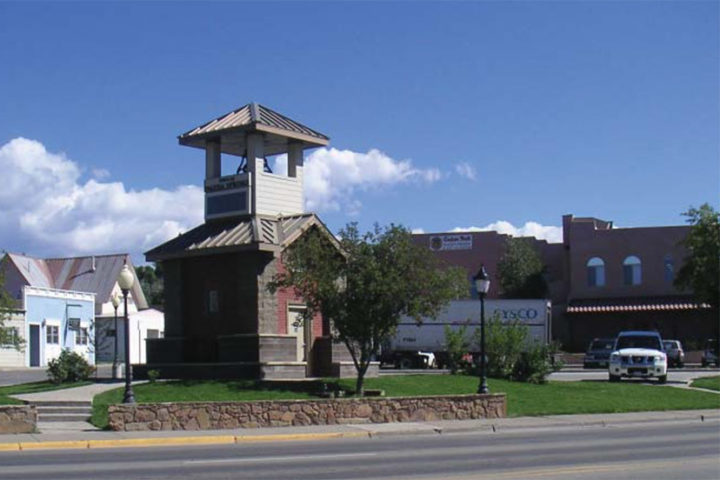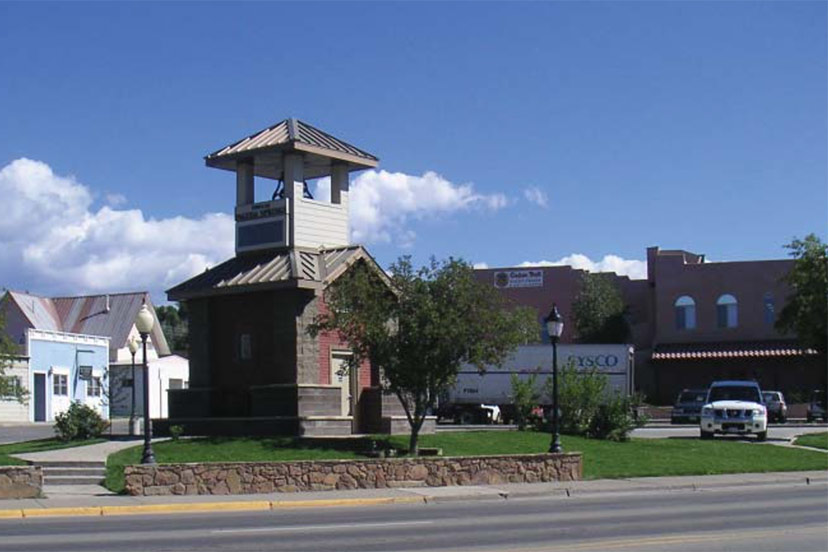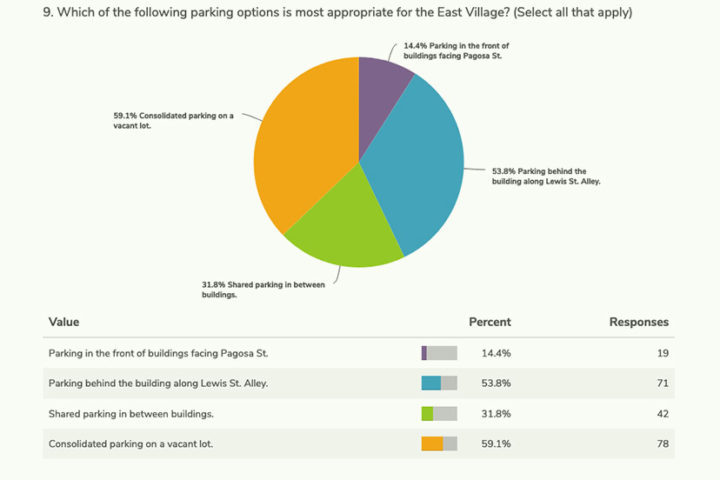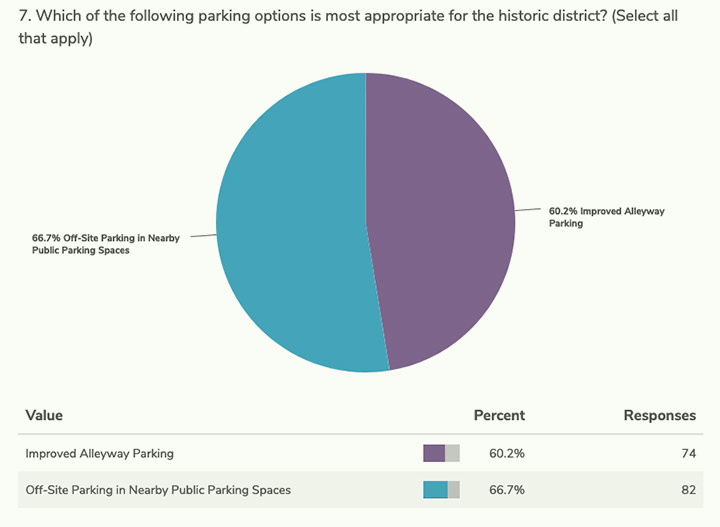Increases in population and tourist visits have heightened the demand for on-street and public parking along some sections of [Highway 160]…
— from the Pagosa Springs Downtown Master Plan, 2007
Years ago, a local realtor asserted in these pages, “If you’re not growing, you’re dying.” I suspect many Americans subscribe to that truism, including 99.9% of the people who’ve been elected to leadership positions in Pagosa Springs in recent years.
At a work session of the Town Planning Commission, on Tuesday evening, I had a sense that everyone in the room (except yours truly) not only embraced ‘growth’ as a positive force, but also the idea that Pagosa’s endless growth is, in fact, inevitable. More people, more tourists, more businesses, more tax revenues, more services…
More traffic.
Of course, the traffic is, by definition, headed somewhere, and not all of it is stopping in downtown Pagosa Springs, looking for a parking spot. In fact, I would suppose most of the traffic is headed to other communities — Durango, Denver, Santa Fe — perhaps even other states. The Grand Canyon, perhaps? That’s a popular destination. Mesa Verde is another. The Durango Train attracts a certain number of tourists.
It’s possible that only a tiny percentage of the vehicles streaming through downtown Pagosa during the summer will actually stop and try to find a parking spot.
I don’t have numbers to justify that opinion, but neither does anyone else.
And that’s apparently one of our parking problems. A lack of good data. As our community has grown, our understanding of certain problems has not necessarily grown proportionately. Nor has there always been a a long-term commitment to solving the problems.
In Part One, we discussed briefly an ongoing Town survey developed by the Planning Department, aimed at getting a better understanding of public opinion around parking in Pagosa’s downtown commercial district. You can participate in the survey, here, even if you live in Houston or Phoenix.
Here’s one of the responses, from the results as tallied on June 29:
The so-called ‘East Village’ was invented by developer David Brown back in 2005. Before that, it was a largely residential district — single family homes — along both sides of Highway 160 between First Street and Third Street. There was a handful of commercial businesses in this district — three restaurants, a bakery, an insurance agent, a dentist, a gas station, couple of thrift shops, an art gallery — but the neighborhood had never had to deal with “parking” as a “problem” that required Town regulations.
Mr. Brown saw the potential to convert this district into a purely commercial district, and he began buying up residential homes in the (newly-designated) ‘East Village’ and tearing them down. (Hence, his nickname, “Tear Down Brown.”) For various reasons, Mr. Brown’s development plans didn’t pan out, and the vacant lots have remained vacant lots, lo, these 15 years. But the single family homes in the ‘East Village’ were converted, one by one, into commercial properties. Only a couple of the homes remain residential.
Of course, the residential homes had not needed parking lots. That historic development pattern — small residential-sized parcels, without commercial-sized parking — posed certain challenges, when converting an entire neighborhood into a commercial district. Especially if you wanted to maintain the “quaint character” of the neighborhood.
Mr. Brown convinced the Town government to embrace his plan to convert the ‘East Village’ to commercial uses, in part by helping to fund a Downtown Master Plan and then getting the Town Council to officially adopt it. In that plan, Mr. Brown’s consultants carefully considered the problem of parking in a residential district in the process of being converted into a commercial district. Some specific recommendations were made.
EV8. Restrict on-site parking to the sides and/ or rear of site. Prohibit parking in the front setback. Landscape exposed areas of parking.
EV9. Minimize private on-site parking lots by cooperatively pursuing shared parking as a district and/or between property owners. Some reductions in parking ratios should be considered where shared parking by complementary uses can be demonstrated.
As noted, this Plan was created by planning experts and was formally adopted by the Town Council… in 2007. Why is the Town Planning Department asking the public about these same issues in 2021?
In particular, why is the Town Planning Department asking people (from Houston and Phoenix?) — people who may have applied not one minute of serious thought to solving complicated parking issues — how the parking regulations should be formulated for the East Village, when the matter was presumably settled, to everyone’s satisfaction, in 2007?
I can imagine a couple of reasons, but I don’t like either of them.
Then we have questions about public parking facilities. Also addressed in the 2007 Downtown Master Plan. And also posed by the Town Planning Department to the survey respondents in the summer of 2021.

The 2007 Plan proposed nine locations for shared public parking, and analyzed the ‘pros’ and ‘cons’ of each site. As far as I can tell, only one of these suggested solutions has been pursued by the Town administration since the adoption of the Plan: parking at the Bell Tower Park, at the corner of Lewis and 160. I think eight parking spots?
Here’s how the general public responded to a confusing question on the same topic, in 2021.
Respondents were asked which options was “most appropriate” and were then allowed to “select all that apply.” Hard to define “most appropriate” when you can pick everything. But a third of the respondents picked nothing at all.
What did our Town administration learn from these responses? Perhaps nothing at all.
I recall, back in 2014, the Archuleta County government was excited about the idea of forming a “Parks & Recreation District” as we’d seen created in certain other Colorado communities. The proposed District would be legally authorized to collect additional tax revenues, earmarked specifically for “parks and recreation.”
To discover the level of support for this new taxing entity, the County Commissioners placed three ‘advisory, non-binding’ questions on the November ballot.
1) Would you be in favor of the Town of Pagosa Springs and Archuleta County combining their park and recreation efforts and programs through the creation of a Parks and Recreation District?
2) If a Parks and Recreation District is formed, it has to be funded. Would you support a permanent sales tax not to exceed 1 cent as the sole source of funding?
3) If a Parks and Recreation District is not created, would you support a sales tax increase over a limited period of time dedicated solely to completing recreation projects such as the town to lakes trail?
When the ballots were counted, the voters had enthusiastically endorsed the idea of forming a Parks & Recreation District.
On the very same ballot, the voters had just as enthusiastically rejected the idea of a sales tax increase, whether connected to a District or not.
Needless to say, no subsequent actions have been taken to form a Parks & Recreation District.
How about those parking solutions? Do we want more parking? And even more importantly, do we want to pay for it?



